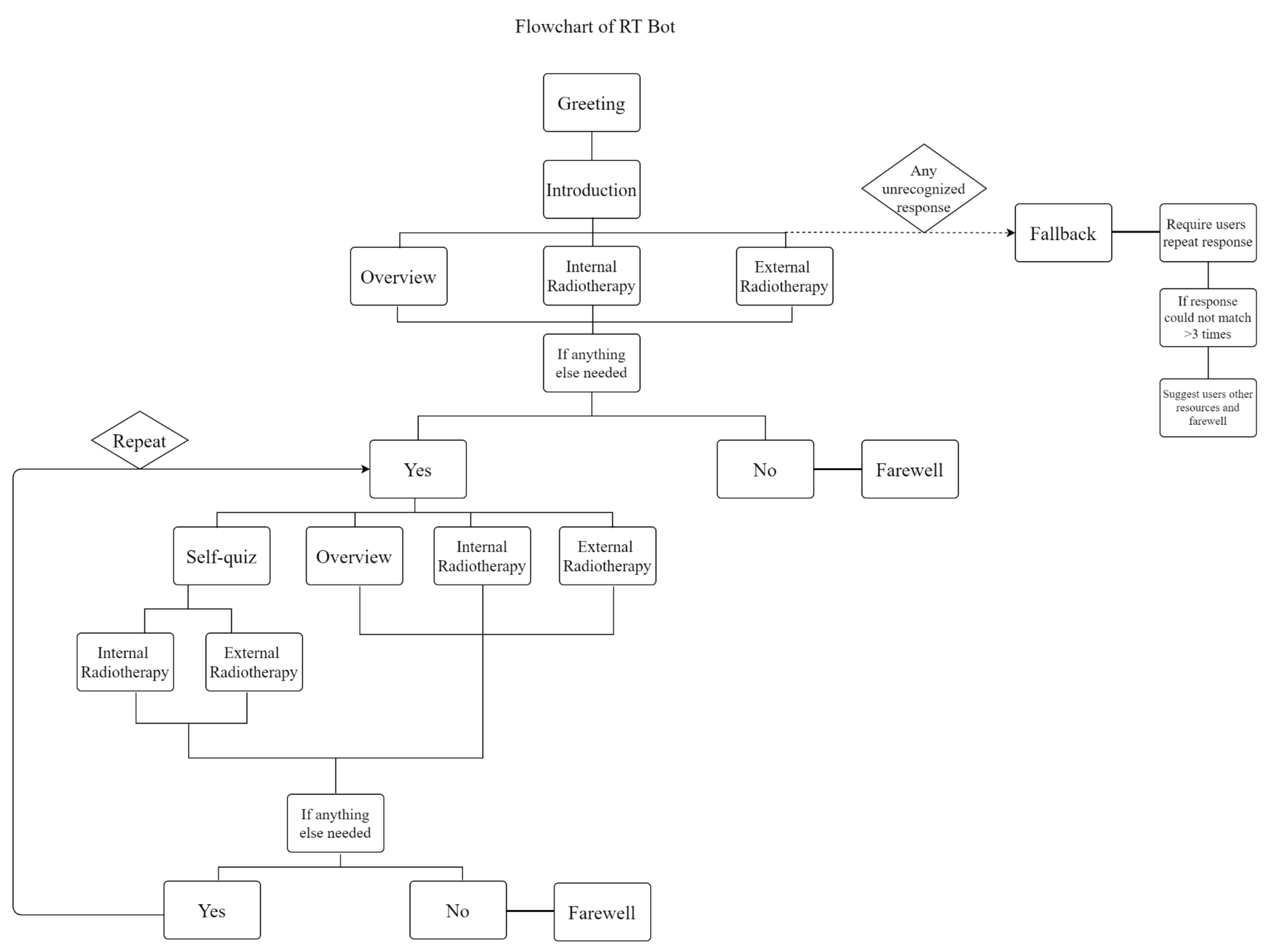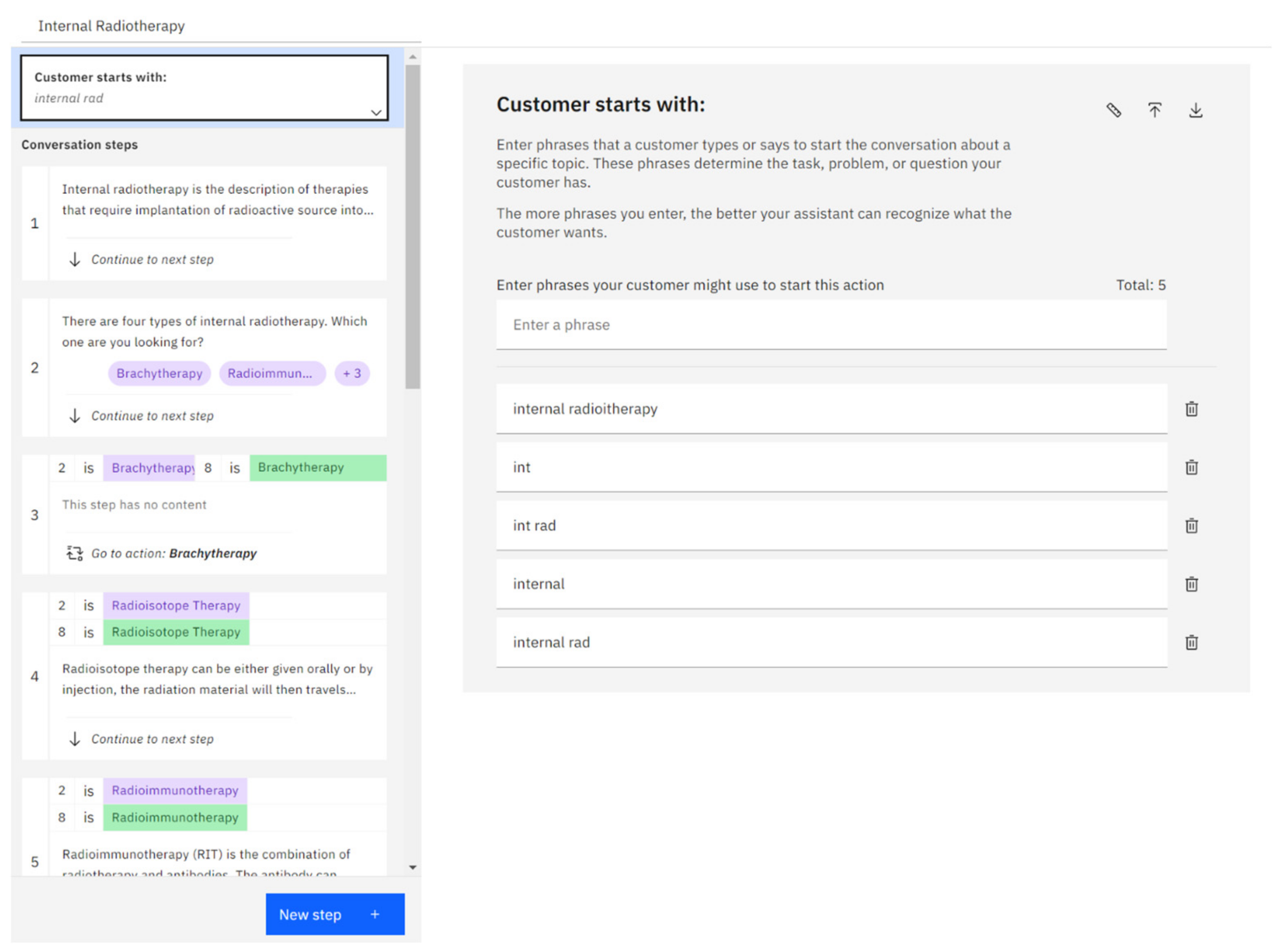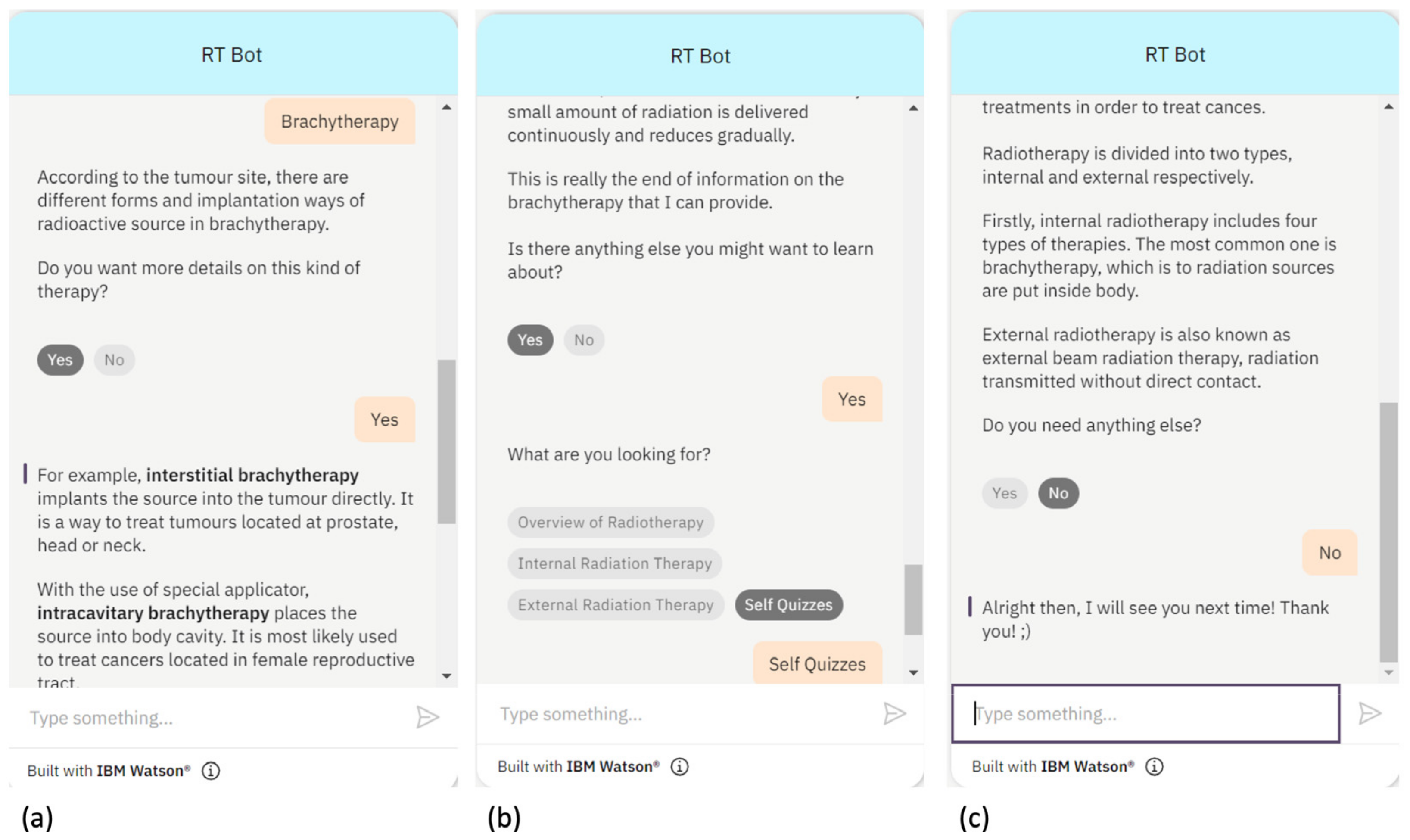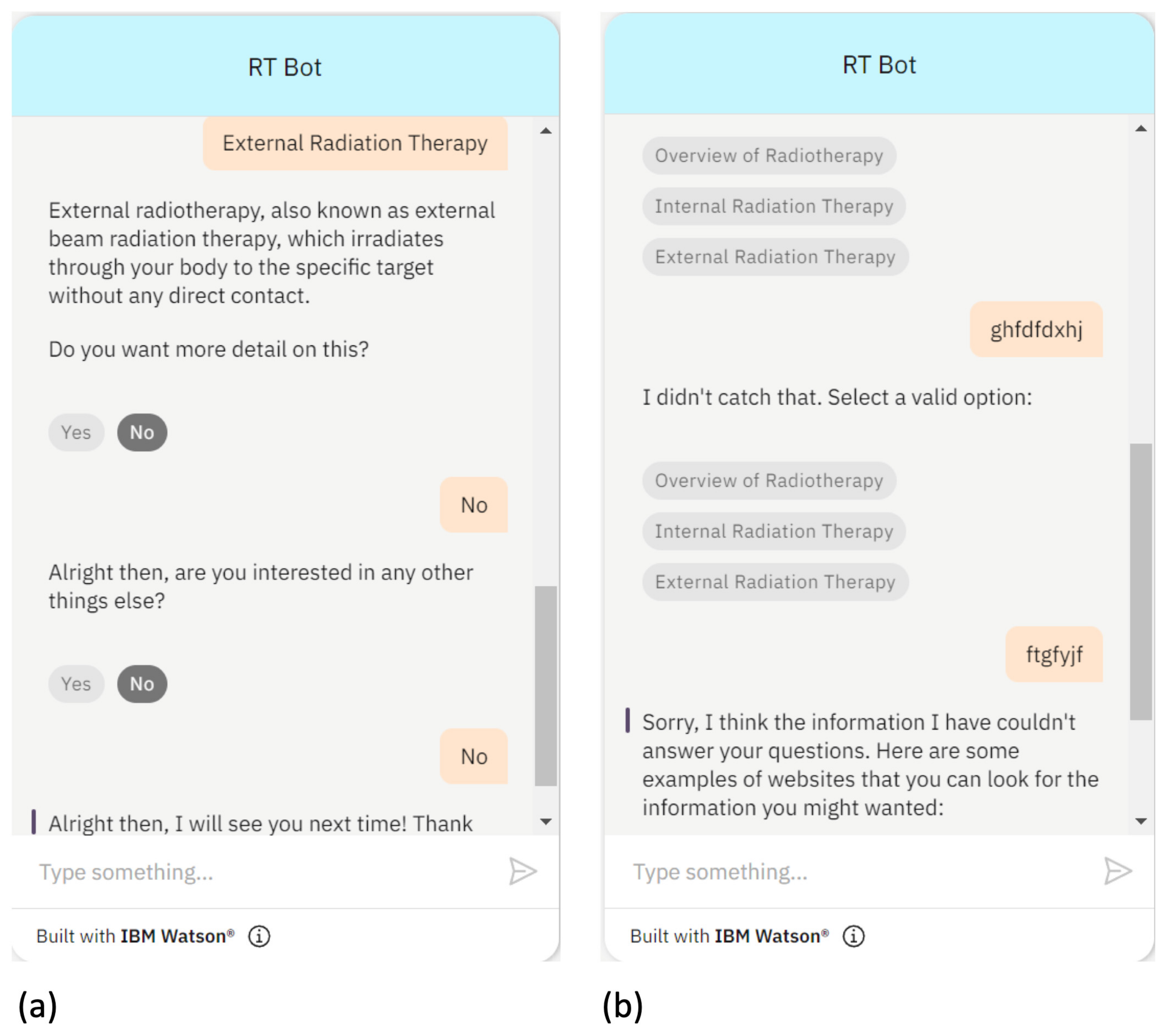Developing an AI-Assisted Educational Chatbot for Radiotherapy Using the IBM Watson Assistant Platform
Abstract
:1. Introduction
2. Materials and Methods
2.1. Dialogue Flowchart
2.2. Creating an AI-Assisted Chatbot
2.3. IBM Watson Assistant Application Programming Interface (API)
2.4. Conversation and Response
2.5. Previewing and Deploying the Chatbot
3. Results
4. Discussion
5. Conclusions
Author Contributions
Funding
Institutional Review Board Statement
Informed Consent Statement
Data Availability Statement
Acknowledgments
Conflicts of Interest
References
- Siddique, S.; Chow, J.C. Machine learning in healthcare communication. Encyclopedia 2021, 1, 220–239. [Google Scholar] [CrossRef]
- Rapp, A.; Curti, L.; Boldi, A. The human side of human-chatbot interaction: A systematic literature review of ten years of research on text-based chatbots. Int. J. Hum.-Comput. Stud. 2021, 151, 102630. [Google Scholar] [CrossRef]
- Tsai, W.H.; Lun, D.; Carcioppolo, N.; Chuan, C.H. Human versus chatbot: Understanding the role of emotion in health marketing communication for vaccines. Psychol. Mark. 2021, 38, 2377–2392. [Google Scholar] [CrossRef] [PubMed]
- Sharma, V.; Goyal, M.; Malik, D. An intelligent behaviour shown by chatbot system. Int. J. New Technol. Res. 2017, 3, 52–54. [Google Scholar]
- Chow, J.C. Artificial intelligence in radiotherapy and patient care. In Artificial Intelligence in Medicine; Springer International Publishing: Cham, Switzerland, 2021; pp. 1–13. [Google Scholar]
- Chow, J.C.; Sanders, L.; Li, K. Design of an Educational Chatbot Using Artificial Intelligence in Radiotherapy. AI 2023, 4, 319–332. [Google Scholar] [CrossRef]
- Jiang, Y.; Yang, X.; Zheng, T. Make chatbots more adaptive: Dual pathways linking human-like cues and tailored response to trust in interactions with chatbots. Comput. Hum. Behavior 2023, 138, 107485. [Google Scholar] [CrossRef]
- Kirakowski, J.; O’Donnell, P.; Yiu, A. Establishing the hallmarks of a convincing chatbot-human dialogue. Hum.-Comput. Interact. 2009, 1, 49–56. [Google Scholar]
- Holsti, L.R. Development of clinical radiotherapy since 1896. Acta Oncol. 1995, 34, 995–1003. [Google Scholar] [CrossRef]
- Mould, R.F. Röntgen and the discovery of X-rays. Br. J. Radiol. 1995, 68, 1145–1176. [Google Scholar] [CrossRef]
- Tanderup, K.; Ménard, C.; Polgar, C.; Lindegaard, J.C.; Kirisits, C.; Pötter, R. Advancements in brachytherapy. Adv. Drug Deliv. Rev. 2017, 109, 15–25. [Google Scholar] [CrossRef]
- Lim, Y.K.; Kim, D. Brachytherapy: A comprehensive review. Prog. Med. Physics. 2021, 32, 25–39. [Google Scholar] [CrossRef]
- Skowronek, J. Current status of brachytherapy in cancer treatment–short overview. J. Contemp. Brachytherapy 2017, 9, 581–589. [Google Scholar] [CrossRef] [PubMed]
- Baskar, R.; Lee, K.A.; Yeo, R.; Yeoh, K.W. Cancer and radiation therapy: Current advances and future directions. Int. J. Med. Sci. 2012, 9, 193. [Google Scholar] [CrossRef] [PubMed]
- Barton, M.B.; Jacob, S.; Shafiq, J.; Wong, K.; Thompson, S.R.; Hanna, T.P.; Delaney, G.P. Estimating the demand for radiotherapy from the evidence: A review of changes from 2003 to 2012. Radiother. Oncol. 2014, 112, 140–144. [Google Scholar] [CrossRef]
- Connell, P.P.; Hellman, S. Advances in radiotherapy and implications for the next century: A historical perspective. Cancer Res. 2009, 69, 383–392. [Google Scholar] [CrossRef] [PubMed]
- Netherton, T.J.; Cardenas, C.E.; Rhee, D.J.; Beadle, B.M. The emergence of artificial intelligence within radiation oncology treatment planning. Oncology 2021, 99, 124–134. [Google Scholar] [CrossRef]
- Nguyen, D.; Lin, M.H.; Sher, D.; Lu, W.; Jia, X.; Jiang, S. Advances in Automated Treatment Planning. In Seminars in Radiation Oncology; WB Saunders: Philadelphia, PA, USA, 2022; Volume 32, pp. 343–350. [Google Scholar]
- Augello, A.; Gentile, M.; Weideveld, L.; Dignum, F. A model of a social chatbot. In Intelligent Interactive Multimedia Systems and Services 2016; Springer: Cham, Switzerland, 2016; pp. 637–647. [Google Scholar]
- Bibault, J.E.; Chaix, B.; Nectoux, P.; Brouard, B. Healthcare ex Machina: Are conversational agents ready for prime time in oncology? Clin. Transl. Radiat. Oncol. 2019, 16, 55–59. [Google Scholar] [CrossRef]
- Chung, K.; Park, R.C. Chatbot-based heathcare service with a knowledge base for cloud computing. Clust. Comput. 2019, 22, 1925–1937. [Google Scholar] [CrossRef]
- Lokman, A.S.; Ameedeen, M.A. Modern chatbot systems: A technical review. In Proceedings of the Future Technologies Conference, Vancouver, BC, Canada, 15–16 November 2018; Springer: Cham, Switzerland, 2018; pp. 1012–1023. [Google Scholar]
- Hiremath, G.; Hajare, A.; Bhosale, P.; Nanaware, R.; Wagh, K.S. Chatbot for education system. Int. J. Adv. Res. Ideas Innov. Technol. 2018, 4, 37–43. [Google Scholar]
- Setiaji, B.; Wibowo, F.W. Chatbot using a knowledge in database: Human-to-machine conversation modeling. In Proceedings of the 2016 7th International Conference on Intelligent Systems, Modelling and Simulation (ISMS), Bangkok, Thailand, 25–27 January 2016; IEEE: Piscataway, NJ, USA, 2016; pp. 72–77. [Google Scholar]
- Heller, B.; Proctor, M.; Mah, D.; Jewell, L.; Cheung, B. Freudbot: An investigation of chatbot technology in distance education. In EdMedia+ Innovate Learning 2005; Association for the Advancement of Computing in Education (AACE): Waynesville, NC, USA, 2005; pp. 3913–3918. [Google Scholar]
- Clarizia, F.; Colace, F.; Lombardi, M.; Pascale, F.; Santaniello, D. Chatbot: An education support system for student. In International Symposium on Cyberspace Safety and Security 2018; Springer: Cham, Switzerland, 2018; pp. 291–302. [Google Scholar]
- Georgescu, A.A. Chatbots for Education–Trends, Benefits and Challenges. In Proceedings of the «eLearning and Software for Education» (eLSE) 2018, Bucharest, Romania, 19–20 April 2018; Romania Advanced Distributed Learning: Bucharest, Romania, 2018; Volume 2, pp. 195–200. [Google Scholar]
- Sabharwal, N.; Barua, S.; Anand, N.; Aggarwal, P. Developing Cognitive Bots Using the IBM Watson Engine: Practical, Hands-on Guide to Developing Complex Cognitive Bots Using the IBM Watson Platform; Apress: New York, NY, USA, 2019. [Google Scholar]
- Nadkarni, P.M.; Ohno-Machado, L.; Chapman, W.W. Natural language processing: An introduction. J. Am. Med. Inform. Assoc. 2011, 18, 544–551. [Google Scholar] [CrossRef]
- Hirschberg, J.; Manning, C.D. Advances in natural language processing. Science 2015, 349, 261–266. [Google Scholar] [CrossRef] [PubMed]
- Liu, P.; Yuan, W.; Fu, J.; Jiang, Z.; Hayashi, H.; Neubig, G. Pre-train, prompt, and predict: A systematic survey of prompting methods in natural language processing. ACM Comput. Surv. 2023, 55, 1–35. [Google Scholar] [CrossRef]
- King, M.R. The future of AI in medicine: A perspective from a chatbot. Ann. Biomed. Eng. 2023, 51, 291–295. [Google Scholar] [CrossRef]
- Chow, J.C.; Sanders, L.; Li, K. Impact of ChatGPT on medical chatbots as a disruptive technology. Front. Artif. Intell 2023, 6, 1166014. [Google Scholar] [CrossRef]
- Safi, Z.; Abd-Alrazaq, A.; Khalifa, M.; Househ, M. Technical aspects of developing chatbots for medical applications: Scoping review. J. Med. Internet Res. 2020, 22, e19127. [Google Scholar] [CrossRef]
- Kovacek, D.; Chow, J.C. An AI-assisted chatbot for radiation safety education in radiotherapy. IOP SciNotes 2021, 2, 034002. [Google Scholar] [CrossRef]
- Morris, R.R.; Kouddous, K.; Kshirsagar, R.; Schueller, S.M. Towards an artificially empathic conversational agent for mental health applications: System design and user perceptions. J. Med. Internet Res. 2018, 20, e10148. [Google Scholar] [CrossRef]
- Liu, B.; Sundar, S.S. Should machines express sympathy and empathy? Experiments with a health advice chatbot. Cyberpsychology Behav. Soc. Netw. 2018, 21, 625–636. [Google Scholar] [CrossRef]
- Lalwani, T.; Bhalotia, S.; Pal, A.; Rathod, V.; Bisen, S. Implementation of a Chatbot System using AI and NLP. Int. J. Innov. Res. Comput. Sci. Technol. 2018, 6, 26–30. [Google Scholar] [CrossRef]
- ChatGPT. ChatGPT: Optimizing Language Models for Dialogue. 2023. Available online: https://openai.com/blog/chatgpt/ (accessed on 23 April 2023).
- Kasneci, E.; Seßler, K.; Küchemann, S.; Bannert, M.; Dementieva, D.; Fischer, F.; Gasser, U.; Groh, G.; Günnemann, S.; Hüllermeier, E.; et al. ChatGPT for good? On opportunities and challenges of large language models for education. Learn. Individ. Differ. 2023, 103, 102274. [Google Scholar] [CrossRef]
- Rebelo, N.; Sanders, L.; Li, K.; Chow, J.C. Learning the Treatment Process in Radiotherapy Using an Artificial Intelligence–Assisted Chatbot: Development Study. JMIR Form. Res. 2022, 6, e39443. [Google Scholar] [CrossRef] [PubMed]
- Swanepoel, D.W.; Manchaiah, V.; Wasmann, J.W. The Rise of AI Chatbots in Hearing Health Care. Hear. J. 2023, 76, 26–30. [Google Scholar] [CrossRef]





| Degree of Satisfaction (1 for Lowest, 5 for Highest) | Helpfulness of Content | Understandability of Content | Reading Time Length |
|---|---|---|---|
| 1 | 5% | 0% | 0% |
| 2 | 0% | 15% | 5% |
| 3 | 25% | 15% | 25% |
| 4 | 40% | 40% | 30% |
| 5 | 30% | 30% | 40% |
Disclaimer/Publisher’s Note: The statements, opinions and data contained in all publications are solely those of the individual author(s) and contributor(s) and not of MDPI and/or the editor(s). MDPI and/or the editor(s) disclaim responsibility for any injury to people or property resulting from any ideas, methods, instructions or products referred to in the content. |
© 2023 by the authors. Licensee MDPI, Basel, Switzerland. This article is an open access article distributed under the terms and conditions of the Creative Commons Attribution (CC BY) license (https://creativecommons.org/licenses/by/4.0/).
Share and Cite
Chow, J.C.L.; Wong, V.; Sanders, L.; Li, K. Developing an AI-Assisted Educational Chatbot for Radiotherapy Using the IBM Watson Assistant Platform. Healthcare 2023, 11, 2417. https://doi.org/10.3390/healthcare11172417
Chow JCL, Wong V, Sanders L, Li K. Developing an AI-Assisted Educational Chatbot for Radiotherapy Using the IBM Watson Assistant Platform. Healthcare. 2023; 11(17):2417. https://doi.org/10.3390/healthcare11172417
Chicago/Turabian StyleChow, James C. L., Valerie Wong, Leslie Sanders, and Kay Li. 2023. "Developing an AI-Assisted Educational Chatbot for Radiotherapy Using the IBM Watson Assistant Platform" Healthcare 11, no. 17: 2417. https://doi.org/10.3390/healthcare11172417
APA StyleChow, J. C. L., Wong, V., Sanders, L., & Li, K. (2023). Developing an AI-Assisted Educational Chatbot for Radiotherapy Using the IBM Watson Assistant Platform. Healthcare, 11(17), 2417. https://doi.org/10.3390/healthcare11172417







